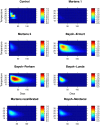How malaria models relate temperature to malaria transmission
- PMID: 23332015
- PMCID: PMC3598736
- DOI: 10.1186/1756-3305-6-20
How malaria models relate temperature to malaria transmission
Abstract
Background: It is well known that temperature has a major influence on the transmission of malaria parasites to their hosts. However, mathematical models do not always agree about the way in which temperature affects malaria transmission.
Methods: In this study, we compared six temperature dependent mortality models for the malaria vector Anopheles gambiae sensu stricto. The evaluation is based on a comparison between the models, and observations from semi-field and laboratory settings.
Results: Our results show how different mortality calculations can influence the predicted dynamics of malaria transmission.
Conclusions: With global warming a reality, the projected changes in malaria transmission will depend on which mortality model is used to make such predictions.
Figures




References
-
- Intergovernmental Panel on Climate Change. Fourth Assessment Report: Climate Change 2007: Working Group I Report: The Physical Science Basis. Geneva: IPCC; 2007.
-
- Sinka ME, Bangs MJ, Manguin S, Coetzee M, Mbogo CM, Hemingway J, Patil AP, Temperley WH, Gething PW, Kabaria CW, Okara RM, Van Boeckel T, Godfray HCJ, Harbach RE, Hay SI. The dominant Anopheles vectors of human malaria in Africa, Europe and the Middle East: occurrence data, distribution maps and bionomic precis. Parasit Vectors. 2010;3:117. doi: 10.1186/1756-3305-3-117. - DOI - PMC - PubMed
Publication types
MeSH terms
LinkOut - more resources
Full Text Sources
Other Literature Sources
Medical

